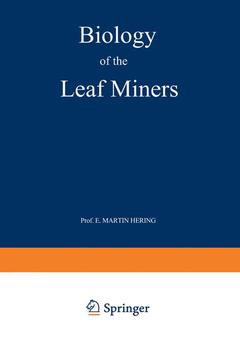Biology of the Leaf Miners, Softcover reprint of the original 1st ed. 1951
Langue : Anglais
Auteur : Hering E.M.

The development of specialised feeding habits during the course of time by human beings is paralleled in the majority of animals, in particular have developed special peculiarities, and insect larvae which in most cases are quite characteristic of the species concerned. This applies especially to phytophagous insect larvae, and anyone with the requisite experience can say with a fair degree of certainty which insect larva is responsible for any damage to be found on a plant. It leaves behind a definite "feeding pattern" which might be compared to a "visiting card" on which the genus and species are marked in runic characters. Whoever has learned to read the runes can readily determine who has been feeding on the affected spot, solely on the basic of the "visiting card" left behind. From the known factors - the name of the plant and the type of feeding patter- and after some study of the various types of plant infestation, both the genus and species of the larva producing the feeding pattern can be worked out without difficulty. The importance of "feeding pattern investigation" has now far outstripped the successes to be obtained by normal collecting. Previously, when wishing to list the species of insects present in any given locality they were caught with the net, by sugaring and other methods. This always resulted in a very defective "list" of the insects in fact existing in the locality concerned.
1. Introduction.- 2. Definition, shape and classification of mines.- 3. Leaf mines and mines in other parts of the plant.- 4. Change in the type of mine. Permanent and temporary miners.- 5. Change from one mine to another.- 6. Mine producers.- 7. Life history of the mining insect.- 8. Duration of mining and connection between mine and seasons of the year.- 9. Disposal of frass in mines.- 10. Case-bearing miners.- 11. Connection between mining habits and larval morphology.- 12. The miners’ choice of food.- 13. Miners on aquatic plants.- 14. Colour and discolouration of mines.- 15. Growth changes in the mined leaf. Mine and gall.- 16. The subsequent fate of the mine.- 17. Instinct change in miners.- 18. Effects of two mines in one leaf. Occurence in profusion.- 19. Parasites and ennemies; inquilines and symbionts.- 20. Damage caused by miners, and their practical value. Geographical distribution.- 21. The study of miners.- Final remarks: Problems and aims of future research on mines.- References.- General Index.
Date de parution : 08-2012
Ouvrage de 420 p.
Thème de Biology of the Leaf Miners :
Mots-clés :
© 2024 LAVOISIER S.A.S.


